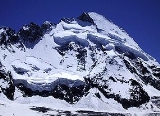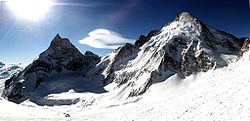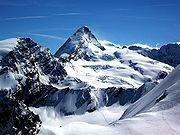
Dent d'Hérens
Encyclopedia
The Dent d'Hérens is a mountain
in the Pennine Alps
, lying on the border between Italy
and Switzerland
. The mountain lies a few kilometres west of the Matterhorn
.
The Aosta hut (2,781 m) is used for the normal route.
, a valley located further to the north. The original name was probably the Dent Blanche, which is now that of the nearby Dent Blanche
which overlooks the Val d'Hérens. On older maps, in the area where both summits lie, only the name Weisszahnhorn (from German: White Tooth Peak) was given, the French name (Dent Blanche) appearing only in 1820. Because cartographers usually made their observations far away from the remoter areas and also because the Dent d'Hérens is sometime hidden behind the Dent Blanche, thus being less visible, the latter received the name. The inhabitants of the lower Val d'Hérens called the Dent d'Hérens, the Dent Blanche, but those of the upper Val d'Hérens called it the Dent de Rong or the Dent d'Erins, contributing to the general confusion. The names used today have been the official ones since the completion of the Dufour map in 1862.
 The Dent d'Hérens is located on the main alpine watershed
The Dent d'Hérens is located on the main alpine watershed
between the Swiss canton of Valais
on the north and the Italian region of Aosta Valley on the south. The northern side of the mountain is part of the drainage basin of the Rhone
, while the south side is part of the drainage basin of the Po River
.
The Dent d'Hérens lies 4 km west of the Matterhorn and north of the village of Cervinia
on the Italian (south) side. On the Swiss (north) side, the mountain rises above the Zmutt Glacier
in the remote valley of Zmutt, 12 km away from the town of Zermatt
. Despite its name suggests, the Dent d'Hérens does not overlook the Val d'Hérens
, as the Dent Blanche
lying a few kilometers to the north do.
of the mountain was by Florence Crauford Grove
, William Edward Hall, Reginald Somerled Macdonald, Montagu Woodmass, Melchior Anderegg
, Jean-Pierre Cachat and Peter Perren on 12 August 1863. The mountain had been attempted a few days before by Edward Whymper
, Jean Antoine Carrel and Luc Meynet but Whymper insisted that they retreat from their planned route up the west ridge because of loose rock. Whymper was annoyed that he had not chosen the line taken up the Grandes Murailles glacier and the south-west flank by Melchior Anderegg on the first ascent and later wrote:
The first winter ascent was by M. Piacenza, J. J. Carrell and G. B. Pellisier on 16 January 1910.
 The 1,300-metre north face was first explored by George Finch
The 1,300-metre north face was first explored by George Finch
, T. G. B. Forster and R. Peto on August 2, 1923 via the North Face Diagonal or 'Finch Route'. A traversing rather than a more directly ascending line, it avoided the main difficulties of the face; these were tackled two years later by the direct line of the 'Welzenbach Route' (Willo Welzenbach and Eugen Allwein) on 10 August 1925, which may be considered the first ascent of the face. On 5 August 1959 Wilfrid Noyce
, together with C. J. Mortlock and Jack Sadler, made the first British ascent of the Welzenbach route. This route was the scene of a large rescue operation on its first winter ascent on 14–17 March 1964. Having climbed the face and bivouacked on the summit, the combined team of German (Gerhard Deweß and Leo Herncarek), Polish (Jerzy Hajdukiewicz and Krzysztof Berbeka) and Swiss (Eckhart Grassmann, Pierre Monkewitz and Dieter Naef) climbers suffered two falls, one of 200 metres, on the descent down the south-west face. The injured climbers were stuck on the mountain for four days before rescue, with Berbeka later dying in hospital and Deweß and Naef requiring amputations.
Mountain
Image:Himalaya_annotated.jpg|thumb|right|The Himalayan mountain range with Mount Everestrect 58 14 160 49 Chomo Lonzorect 200 28 335 52 Makalurect 378 24 566 45 Mount Everestrect 188 581 920 656 Tibetan Plateaurect 250 406 340 427 Rong River...
in the Pennine Alps
Pennine Alps
The Pennine Alps are a mountain range in the western part of the Alps. They are located in Switzerland and Italy...
, lying on the border between Italy
Italy
Italy , officially the Italian Republic languages]] under the European Charter for Regional or Minority Languages. In each of these, Italy's official name is as follows:;;;;;;;;), is a unitary parliamentary republic in South-Central Europe. To the north it borders France, Switzerland, Austria and...
and Switzerland
Switzerland
Switzerland name of one of the Swiss cantons. ; ; ; or ), in its full name the Swiss Confederation , is a federal republic consisting of 26 cantons, with Bern as the seat of the federal authorities. The country is situated in Western Europe,Or Central Europe depending on the definition....
. The mountain lies a few kilometres west of the Matterhorn
Matterhorn
The Matterhorn , Monte Cervino or Mont Cervin , is a mountain in the Pennine Alps on the border between Switzerland and Italy. Its summit is 4,478 metres high, making it one of the highest peaks in the Alps. The four steep faces, rising above the surrounding glaciers, face the four compass points...
.
The Aosta hut (2,781 m) is used for the normal route.
Naming
The mountain takes its name from the Val d'HérensVal d'Hérens
Val d'Hérens is an alpine valley in the Valais canton of Switzerland. It was formed by the Hérens glacier, which retreated at the end of the last ice age....
, a valley located further to the north. The original name was probably the Dent Blanche, which is now that of the nearby Dent Blanche
Dent Blanche
The Dent Blanche is a mountain in the Pennine Alps, lying in the canton of Valais in Switzerland. With its high summit, it is one of the highest peaks in the Alps.-Naming:...
which overlooks the Val d'Hérens. On older maps, in the area where both summits lie, only the name Weisszahnhorn (from German: White Tooth Peak) was given, the French name (Dent Blanche) appearing only in 1820. Because cartographers usually made their observations far away from the remoter areas and also because the Dent d'Hérens is sometime hidden behind the Dent Blanche, thus being less visible, the latter received the name. The inhabitants of the lower Val d'Hérens called the Dent d'Hérens, the Dent Blanche, but those of the upper Val d'Hérens called it the Dent de Rong or the Dent d'Erins, contributing to the general confusion. The names used today have been the official ones since the completion of the Dufour map in 1862.
Geography

Main chain of the Alps
The Alpine divide is the central line of mountains that forms the water divide of the range. Main chains of mountain ranges are traditionally designated in this way, and generally include the highest peaks of a range; the Alps are something of an unusual case in that several significant groups of...
between the Swiss canton of Valais
Valais
The Valais is one of the 26 cantons of Switzerland in the southwestern part of the country, around the valley of the Rhône from its headwaters to Lake Geneva, separating the Pennine Alps from the Bernese Alps. The canton is one of the drier parts of Switzerland in its central Rhône valley...
on the north and the Italian region of Aosta Valley on the south. The northern side of the mountain is part of the drainage basin of the Rhone
Rhône
Rhone can refer to:* Rhone, one of the major rivers of Europe, running through Switzerland and France* Rhône Glacier, the source of the Rhone River and one of the primary contributors to Lake Geneva in the far eastern end of the canton of Valais in Switzerland...
, while the south side is part of the drainage basin of the Po River
Po River
The Po |Ligurian]]: Bodincus or Bodencus) is a river that flows either or – considering the length of the Maira, a right bank tributary – eastward across northern Italy, from a spring seeping from a stony hillside at Pian del Re, a flat place at the head of the Val Po under the northwest face...
.
The Dent d'Hérens lies 4 km west of the Matterhorn and north of the village of Cervinia
Cervinia
Breuil-Cervinia is an alpine resort in the Valle d'Aosta region of northwest Italy...
on the Italian (south) side. On the Swiss (north) side, the mountain rises above the Zmutt Glacier
Zmutt Glacier
The Zmutt Glacier is a long glacier situated in the Pennine Alps in the canton of Valais in Switzerland. In 1973 it had an area of .-External links:*...
in the remote valley of Zmutt, 12 km away from the town of Zermatt
Zermatt
Zermatt is a municipality in the district of Visp in the German-speaking section of the canton of Valais in Switzerland. It has a population of about 5,800 inhabitants....
. Despite its name suggests, the Dent d'Hérens does not overlook the Val d'Hérens
Val d'Hérens
Val d'Hérens is an alpine valley in the Valais canton of Switzerland. It was formed by the Hérens glacier, which retreated at the end of the last ice age....
, as the Dent Blanche
Dent Blanche
The Dent Blanche is a mountain in the Pennine Alps, lying in the canton of Valais in Switzerland. With its high summit, it is one of the highest peaks in the Alps.-Naming:...
lying a few kilometers to the north do.
Climbing history
The first ascentFirst ascent
In climbing, a first ascent is the first successful, documented attainment of the top of a mountain, or the first to follow a particular climbing route...
of the mountain was by Florence Crauford Grove
Florence Crauford Grove
Florence Crauford Grove was an English mountaineer and author, sometimes known as F. Crauford Grove.-Mountaineer:Grove became an experienced alpinist in the late 1850s and joined the Alpine Club of London soon after it was formed in 1857, later serving as its President from 1884 to 1886...
, William Edward Hall, Reginald Somerled Macdonald, Montagu Woodmass, Melchior Anderegg
Melchior Anderegg
Melchior Anderegg , from Zaun, Meiringen, was a Swiss mountain guide and the first ascensionist of many prominent mountains in the western Alps during the golden and silver ages of alpinism...
, Jean-Pierre Cachat and Peter Perren on 12 August 1863. The mountain had been attempted a few days before by Edward Whymper
Edward Whymper
Edward Whymper , was an English illustrator, climber and explorer best known for the first ascent of the Matterhorn in 1865. On the descent four members of the party were killed.-Early life:...
, Jean Antoine Carrel and Luc Meynet but Whymper insisted that they retreat from their planned route up the west ridge because of loose rock. Whymper was annoyed that he had not chosen the line taken up the Grandes Murailles glacier and the south-west flank by Melchior Anderegg on the first ascent and later wrote:
- This was the only mountain in the Alps that I have essayed to ascend, that has not, sooner or later, fallen to me. Our failure was mortifying . . .
The first winter ascent was by M. Piacenza, J. J. Carrell and G. B. Pellisier on 16 January 1910.

George Finch (chemist)
George Ingle Finch FRS was a chemist and mountaineer.He was born in Australia but educated in German-speaking Switzerland and studied physical sciences at Geneva University....
, T. G. B. Forster and R. Peto on August 2, 1923 via the North Face Diagonal or 'Finch Route'. A traversing rather than a more directly ascending line, it avoided the main difficulties of the face; these were tackled two years later by the direct line of the 'Welzenbach Route' (Willo Welzenbach and Eugen Allwein) on 10 August 1925, which may be considered the first ascent of the face. On 5 August 1959 Wilfrid Noyce
Wilfrid Noyce
Cuthbert Wilfrid Francis Noyce was an English mountaineer and author...
, together with C. J. Mortlock and Jack Sadler, made the first British ascent of the Welzenbach route. This route was the scene of a large rescue operation on its first winter ascent on 14–17 March 1964. Having climbed the face and bivouacked on the summit, the combined team of German (Gerhard Deweß and Leo Herncarek), Polish (Jerzy Hajdukiewicz and Krzysztof Berbeka) and Swiss (Eckhart Grassmann, Pierre Monkewitz and Dieter Naef) climbers suffered two falls, one of 200 metres, on the descent down the south-west face. The injured climbers were stuck on the mountain for four days before rescue, with Berbeka later dying in hospital and Deweß and Naef requiring amputations.

